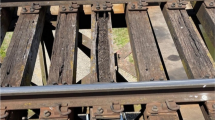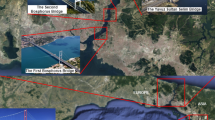Abstract
A new mechanics model, which reveals additional longitudinal force transmission between the continuously welded rails and the bridges, is established on the fact that the influence of the mutual relative displacement among the rail, the sleeper and the beam is taken into account. An example is presented and numerical results are compared. The results show that the additional longitudinal forces calculated with the new model are less than those of the previous, especially in the case of the flexible pier bridges. The new model is also suitable for the analysis of the additional longitudinal force transmission between rails and bridges of ballastless track with small resistance fasteners without taking the sleeper displacement into account, and compared with the ballast bridges, the ballastless bridges have a much stronger additional longitudinal force transmission between the continuously welded rails and the bridges.
Similar content being viewed by others
References
LOU Yao-rong, FENG Shu-qing. Calculation method for the discrete force of CWR on railway bridge[J]. Journal of the China Railway Society, 1987, 9(2):56–67. (in Chinese)
LI Guo-qing, ZHUANG Jun-sheng, ZHANG Shichen. Study on longitudinal additional force in continuously welded rails on high-speed railway bridges[J]. China Railway Science, 1997, 18(3):15–23. (in Chinese)
JIANG Jin-zhou. Additional longitudinal force in continuously welded rails and their transmission on railway bridges[J]. China Railway Science, 1998, 19(2):67–75. (in Chinese)
YIN Cun-xin. Dynamic analysis of railway bridge response to longitudinal braking force[J]. China Railway Science, 2000, 21(2): 8–18. (in Chinese)
LI Xi-ya. Synthetic formulas for additional longitudinal force in continuously welded rails and bridges [J]. Journal of the China Railway Society, 1993, 15(2): 85–92. (in Chinese)
LIU Di-hua. Interactive bending force of bridge and track of high pier bridge[J]. China Railway Science, 1995, 16(3),72–80. (in Chinese)
JIANG Hai-bo, WU Xin. Three-dimensional conjunct model: for the research on the longitudinal forces of urban mass transit continuous welded rails[J]. Urban Mass Transit, 2003(1): 33–37. (in Chinese)
LI Hong-nian, ZHU Xi, YU Xing-jie. Research on effective coefficient of braking force of simply supported PC-beam railway bridges[J]. China Civil Engineering Journal, 2000, 33(3): 22–30. (in Chinese)
GENG Chuan-zhi. Analysis of bridge/rail interaction force of jointless tracks on rubber support bridge[J]. Journal of Shanghai Institute of Railway Technology, 1995, 16(3): 10–16. (in Chinese)
XU Qing-yuan. Study on additional force transmission between continuously welded rails and continuous beam bridge[J]. China Railway Science, 2003, 24(3): 58–63. (in Chinese)
Geissler K, Grasse W, Schmachtenberg R. Measurement based determination of braking and traction forces at the railway bridge in Rendsburg[J]. Stahlbau, 2002,71(10): 735–747. (in German)
Eickmann C, Klaus M. Dissipation of longitudinal forces on railway bridges due to temperature influences[J]. Eisenbahningenieur, 2001,52(2): 36–40. (in German)
Fryba L. Thermal interaction of long welded rails with railway bridges[J]. Rail International, 1985, 16(3): 5–24.
Czyczula W, Solkowski J, Towpik K. Interaction between CWR track and bridges in longitudinal direction [J]. Archives of Civil Engineering, 1997, 43(1): 51–69.
Arya A S, Ggrawal S R. Dispersion of tractive and braking forces forces in railway bridges-theoretical analysis[J]. Rail International, 1982, 13(4): 12–25.
Author information
Authors and Affiliations
Corresponding author
Additional information
Foundation item: Project(2001G049) supported by the Foundation of the Science and Technology Section of Ministry of Railway of China
Rights and permissions
About this article
Cite this article
Xu, Qy., Zhou, Xl., Zeng, Zp. et al. Mechanics model of additional longitudinal force transmission between bridges and continuously welded rails with small resistance fasteners. J Cent. South Univ. Technol. 11, 336–339 (2004). https://doi.org/10.1007/s11771-004-0069-3
Received:
Accepted:
Issue Date:
DOI: https://doi.org/10.1007/s11771-004-0069-3




